Crown Roast of Lamb
Holidays time are a time for celebratory meals—things we wouldn’t eat every day. Easter and Christmas, for example, are not the time for standard week-night foods, but a festive dish to be shared with loved ones. And for that, crown roast of lamb is hard to beat.
Lamb is already a festive meat, and its rarity in our diet helps to accentuate its specialness. Turn it into an amazing-looking crown that comes to the table brimming with savory sides and you have a meal fit for royalty. And, unlike a turkey, it’s a centerpiece that you can actually carve at the table. So read on and learn how to create a crown roast, all the way from tying it to the pull temps.
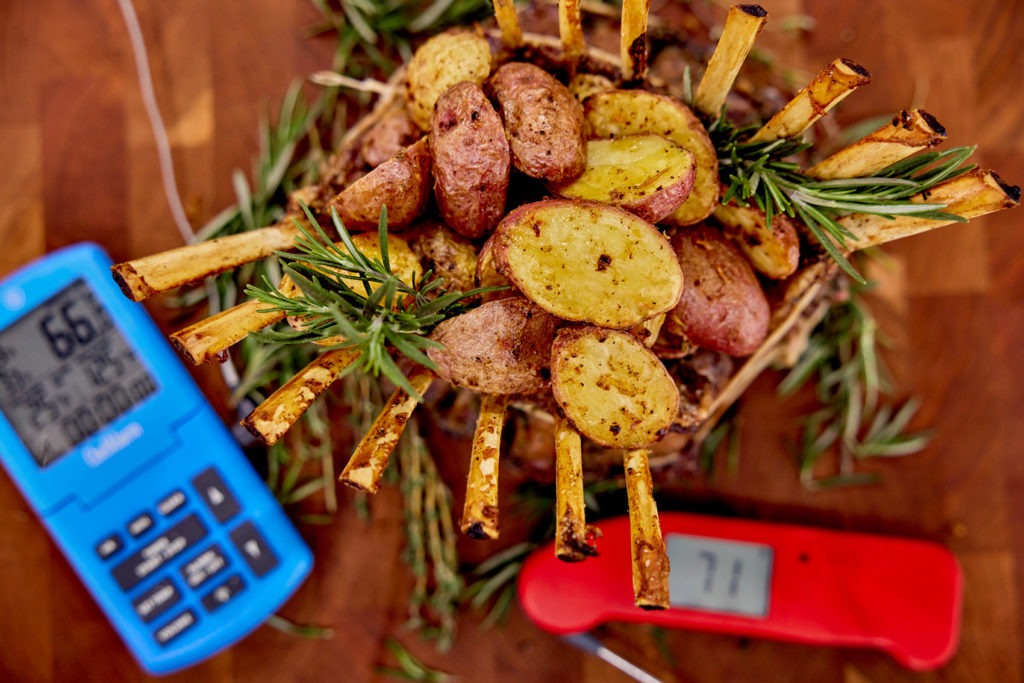
Contents
- How to tie a crown roast
- Important temperatures for a crown roast of lamb
- Crown roast of lamb recipe
How to tie a crown roast of lamb
You can usually order a crown roast of lamb tied from your local butcher, but if you love doing things yourself or don’t want to pay the extra cost that may be associated with buying a pre-tied roast, then tying it at home is the way to go! You’ll need two racks of lamb that are the same size, some butcher’s twine, a soup can, and some aluminum foil.
First, in order to transform the flat surface of the lamb racks into the curved surface of the crown, we must create hinge-points. To do this, place the racks bone-side up and cut small slits between the ends of each bone in the thick of the meat. This will allow for some bend in the loins.
Next, cut another shallow slit along the length of the loins, also on the bone side, perpendicular to the bones, at their ends. This slit allows you to easily tie the roast into a crown shape and will also allow a purchase for the seasonings.
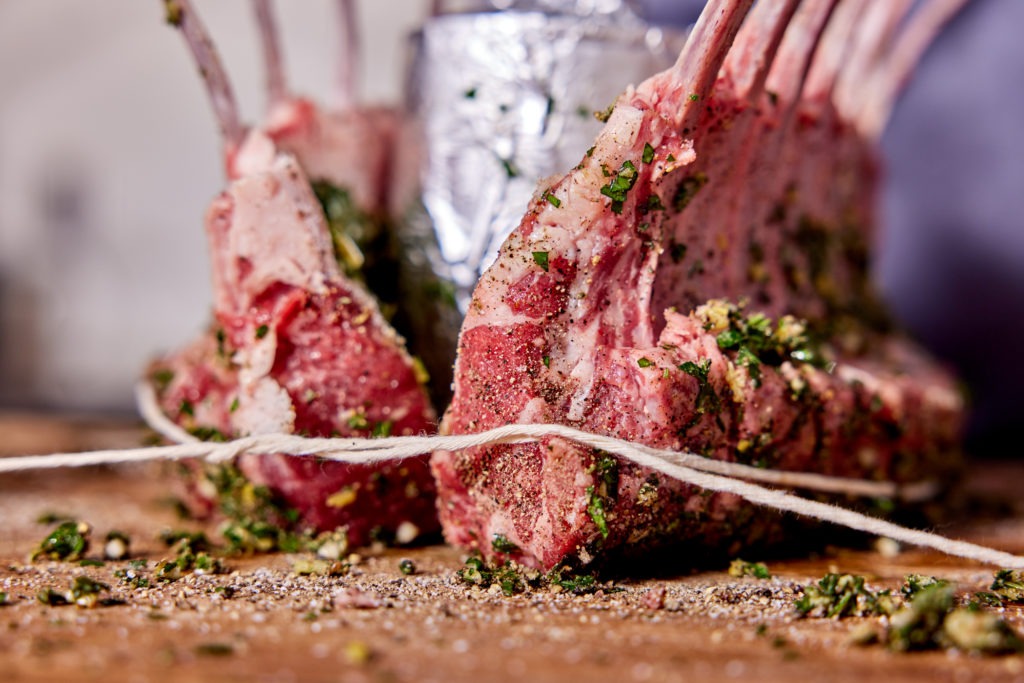
To create the crown, wrap the soup can in aluminum foil (to keep things sanitary) and place it on a work surface. Lean each loin’s meaty side against the wrapped can. Bend them so that their ends meet, deepening with a sharp knife any between-the-bone slits that you need to so that they can meet. Using lengths of butcher twine, tie around the loins with the string running through the channel you’ve cut in the bottom of the bones. Tighten the string. Also tie a length of twine around the ribs, settling it in the most concave part.
Remove the soup can and squish and squeeze the roast into the best circle you can. And there you have it: a crown roast of lamb.
For the very best presentation, you cancap the bare bones with foil before you put the roast in the oven. This will keep the bones more stark white. One sheet that caps the whole top will be fine—there’s no need to cap the individual bones. If you leave the cap off, you’ll get a bit more of a roasty color, but nothing so bad as charring.
Crown roast of lamb temperatures
Rack of lamb is more expensive per pound than many of the cuts that you might usually buy. Given that expense, it is super important to get the doneness temperature right for this roast. Since the roast will be cooked at a high temperature and the meat is not particularly massive, monitoring the internal temperature is of utmost importance. Use a ChefAlarm® to keep an eye on the temperature and to alert you when it’s time to pull it out of the oven. Of course, a Thermapen® ONE is the best tool for verifying those temperatures when the time comes.
But how done should it be? Lamb is most often eaten on the rarer side than beef, even. Even if you usually like medium-done beef, I recommend medium-rare lamb. You can reference the chart below for final temperatures, but know that at this temperature you’re likely to get 5–10°F (3–6°C) of carryover cooking. Plan your pull time accordingly. For our medium-rare rack, we pulled the meat at 127°F (53°C) and it was perfect!
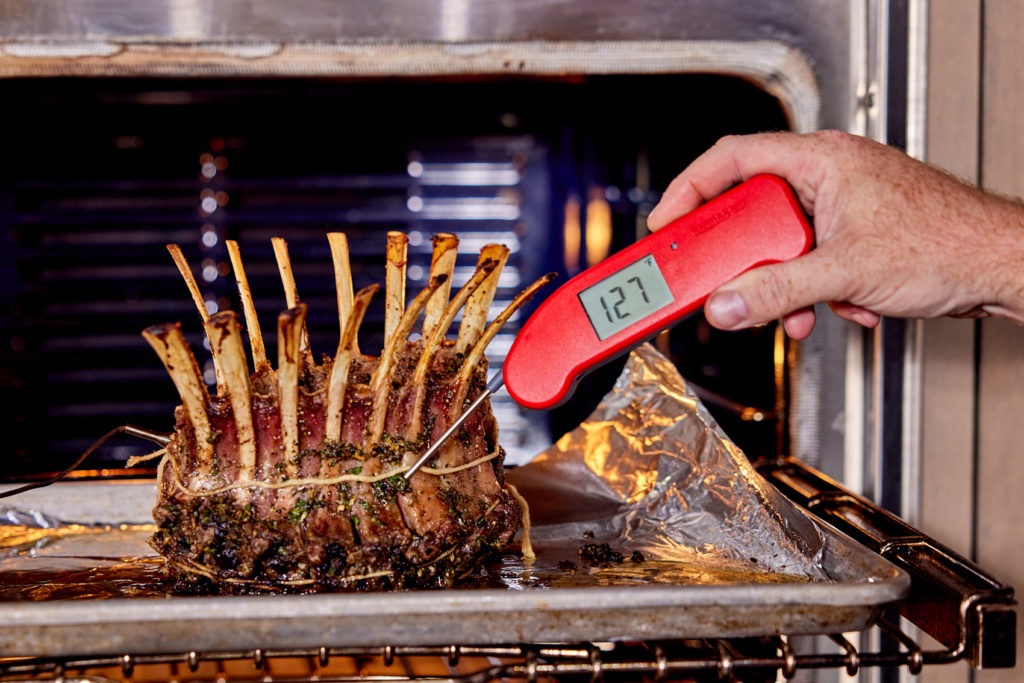
Lamb Roast Doneness Temperature Chart
| Preferred Doneness | Degrees F | Degrees C |
|---|---|---|
| Rare | 120-129°F | (49-54°C) |
| Medium Rare | 130-134°F | (55-57°C) |
| Medium | 135-144°F | (58-62°C) |
| Medium Well | 145-154°F | (63-67°C) |
| Well Done | 155-164°F | (68-73°C) |
Note on stuffing:
You may see pictures of crown roasts filled to the brim with savory stuffings or roasted vegetables. While that is a perfectly acceptable way to serve your roast, it is not a great way to cook your roast. The principle is the same as for the reason to not stuff a turkey: it takes longer to cook the stuffing and you will likely overcook the tender meat. So roast those veggies, prepare that couscous, or sauté those Brussels sprouts, but add them on the way to the table, not the way to the oven.
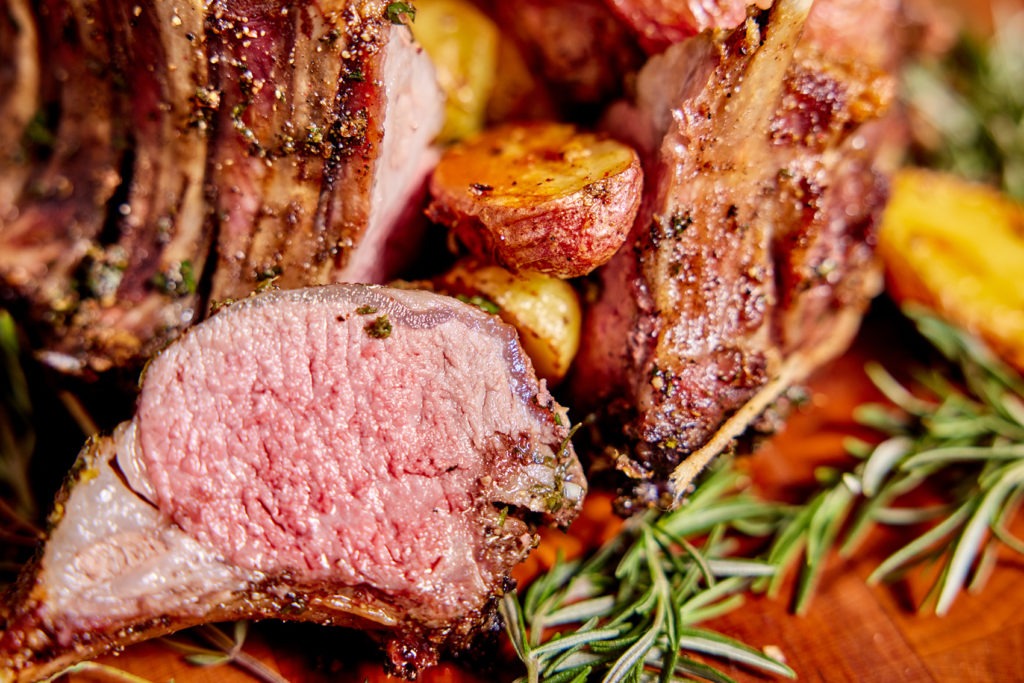
A crown rack of lamb is a beautiful, warmly-flavored, and satisfying center to a festive dinner, and can be prepared at nearly the last minute, provided you have the lamb on hand. For a holiday dinner like this, you absolutely want to cook the roast just right so that the flavor of the meat echoes the glory of the presentation, and for that, you need to monitor the temperature. Lamb racks are easy to overcook, so use your ChefAlarm and Thermapen ONE to get things just right.
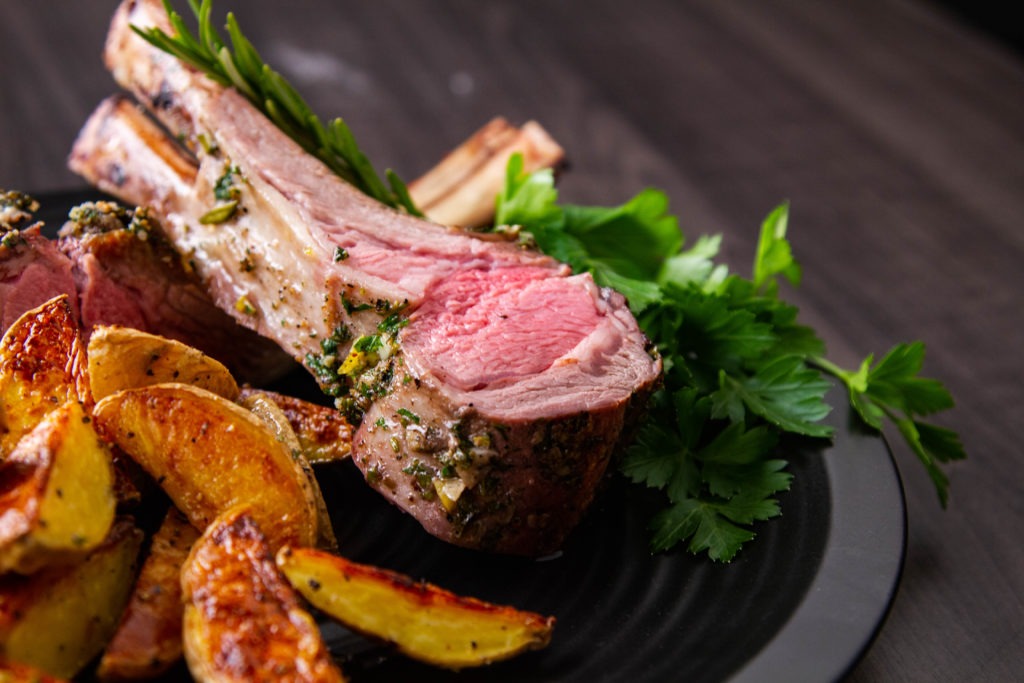
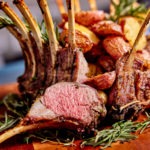
Crown Roast of Lamb
Description
Adapted from Crown Roast of Lamb with Rosemary and Oregano, from Epicurious.com
Ingredients
- 2 Tbsp chopped fresh rosemary
- 6 garlic cloves, minced
- 1 Tbsp chopped fresh thyme
- 2 Tbsp chopped fresh parsley
- 1 tsp lemon zest
- 1 ½ tsp salt
- 1 tsp ground black pepper
- 2 Frenched racks of lamb, each consisting of 7 ribs
- Olive oil
Instructions
- Preheat oven to 425°F (218°C).
- On the side of the racks with the bones, cut a shallow slit—about ¼-inch—in the thick of the meat between each rib’s end.
- Cut another shallow slit perpendicular to and at the end of all the bones, separating their ends from the thick meat.
- Combine herbs, garlic, lemons zest, oil, salt, and pepper.
- Rub roast all over with the seasoning mixture, including the bottom of the crown and deep in the slits that you cut earlier.
- Cover a soup can in aluminum foil and set it on your work surface.
- Use the soup can to curve the rib racks, bone-side out, and tie them into a circle. Tie the racks in the hollow of the bones and also in the slit you cut beneath the bones. Use a slip-knot that you can cinch down to tighten the string.
- Remove the soup can and adjust the shape of your crown roast so that it is mostly circular.
- Insert a Pro-Series® robe from a ChefAlarm into the meat in the thickest part. Set the high alarm for 125°F (52°C) for medium-rare.
- If you like, cap the bare bones with a sheet of foil to prevent them from darkening.
- Place the roast on a sheet pan and roast it until the desired temperature is reached. This should take about 25-30 minutes.
- Verify the temperature with a Thermapen.
- Allow the roast to rest, then untie it. If you like bring it to the table filled with roasted vegetables or another stuffing that you have prepared separately.
- Serve by slicing into chops between the ribs.
Shop now for products used in this post:


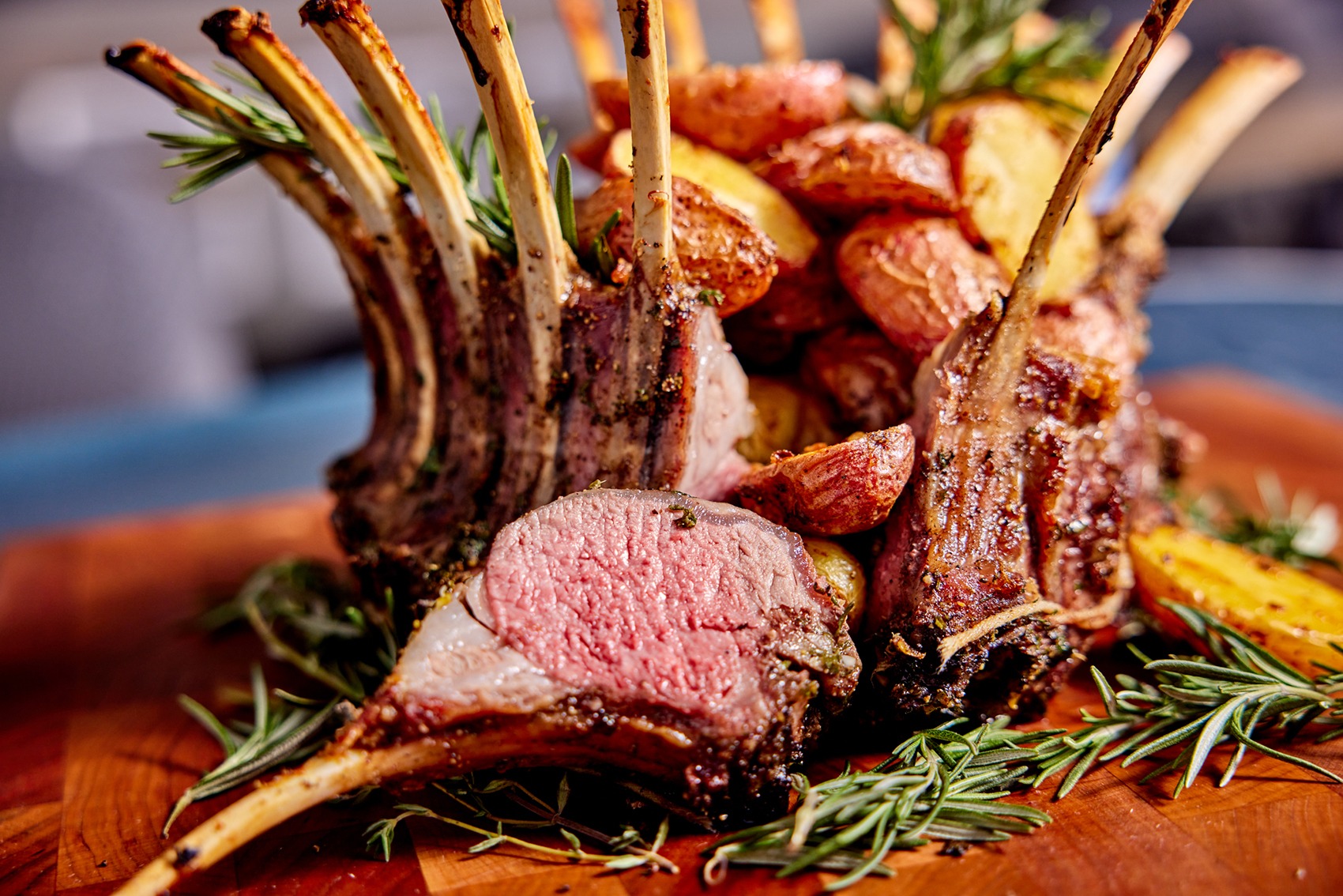
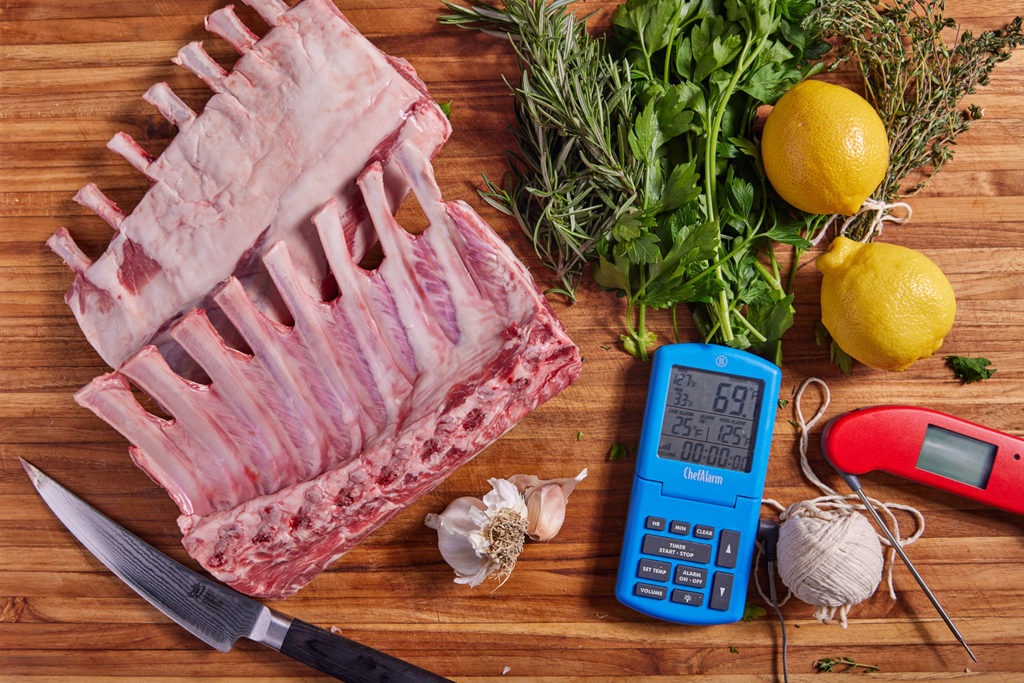
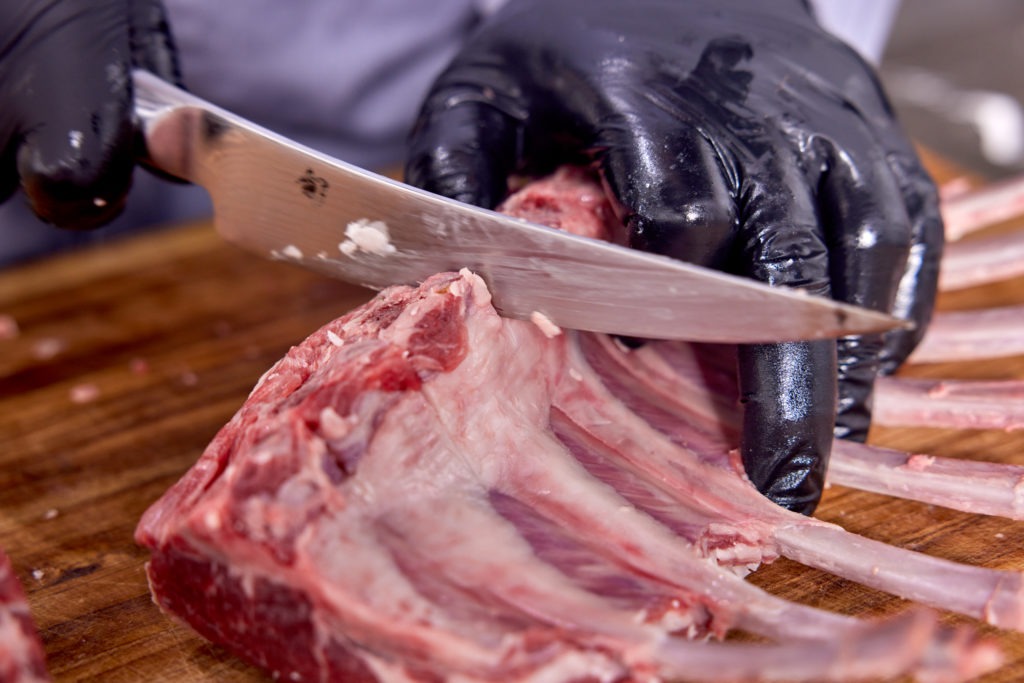
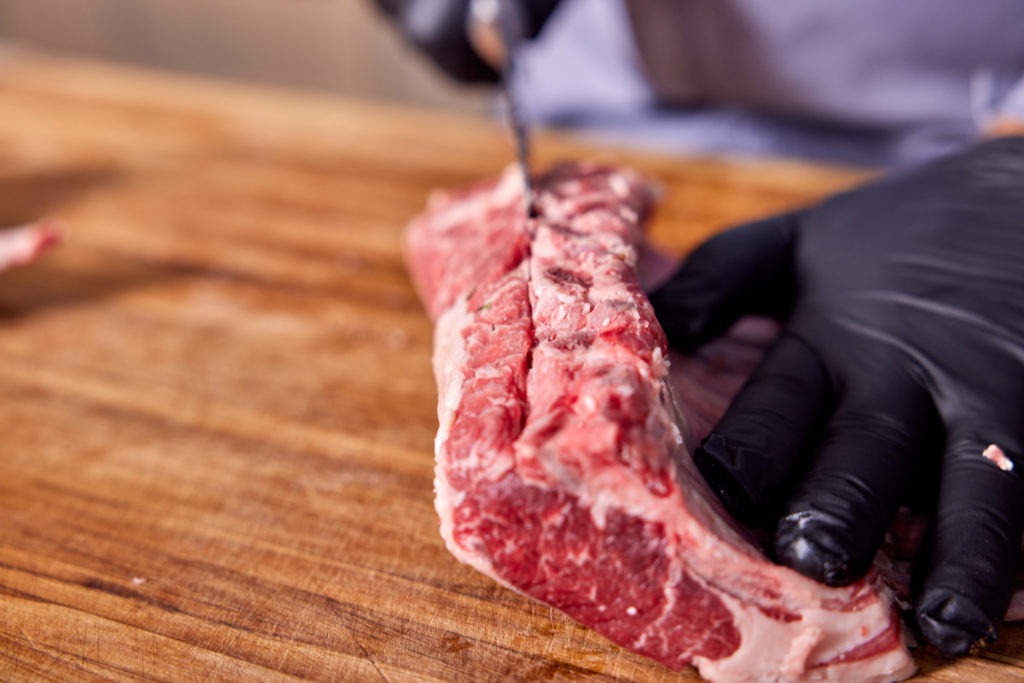
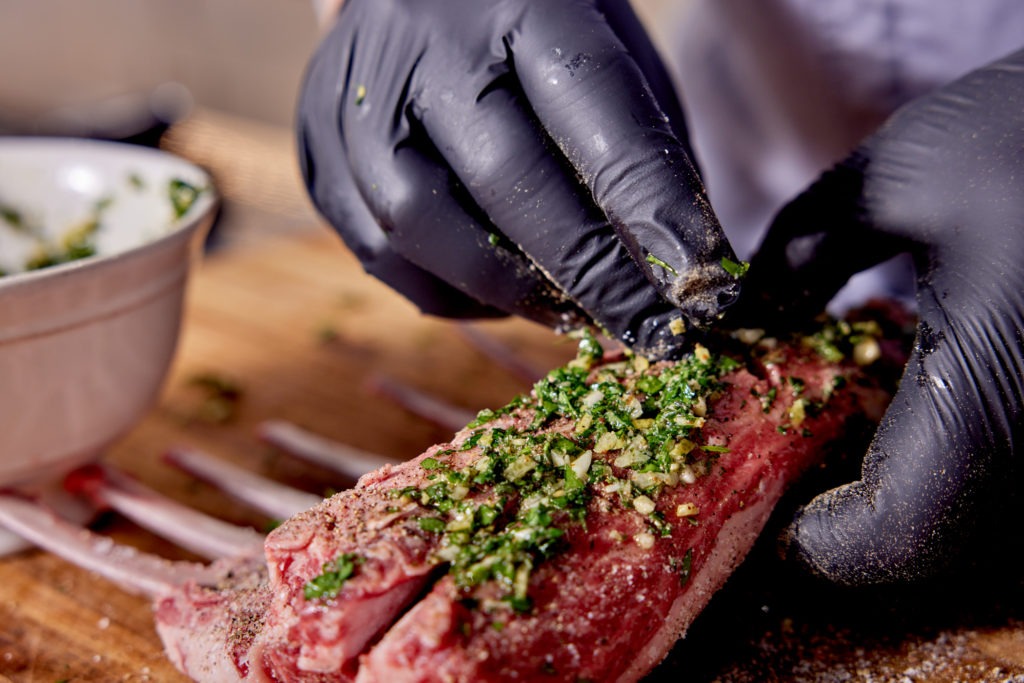
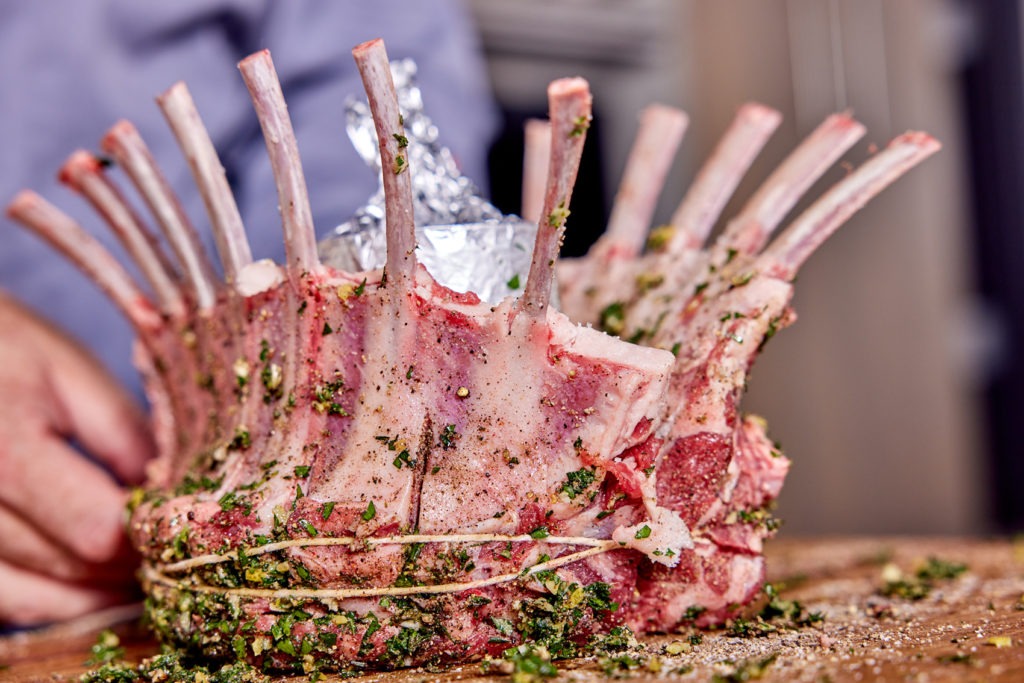
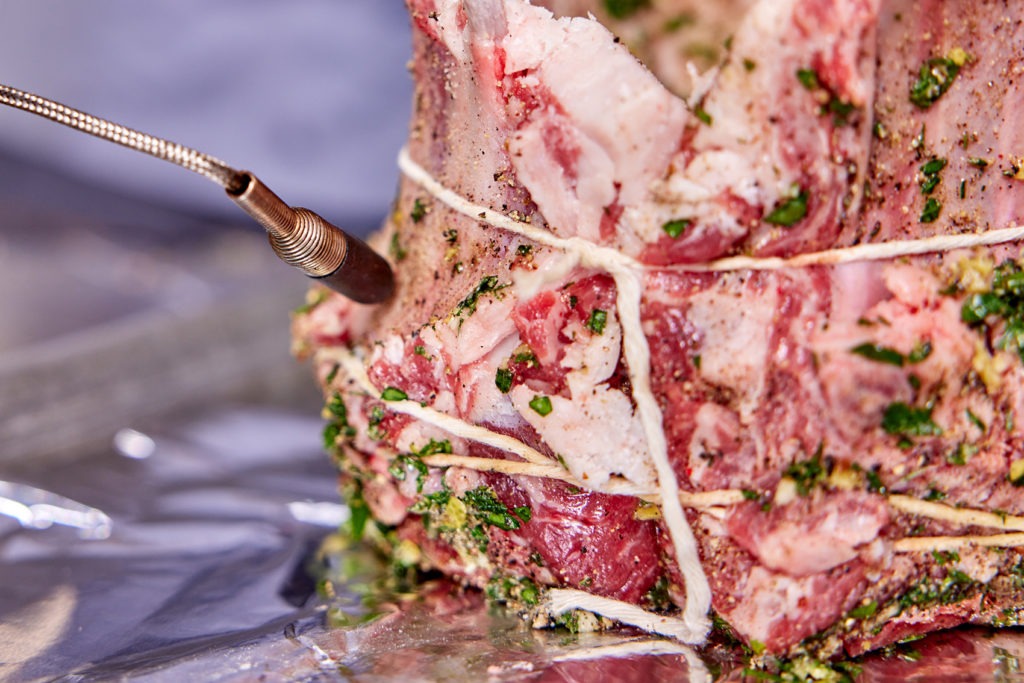
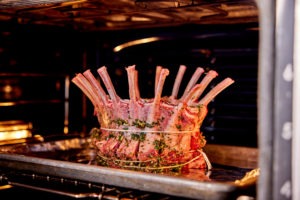
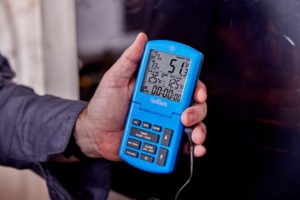
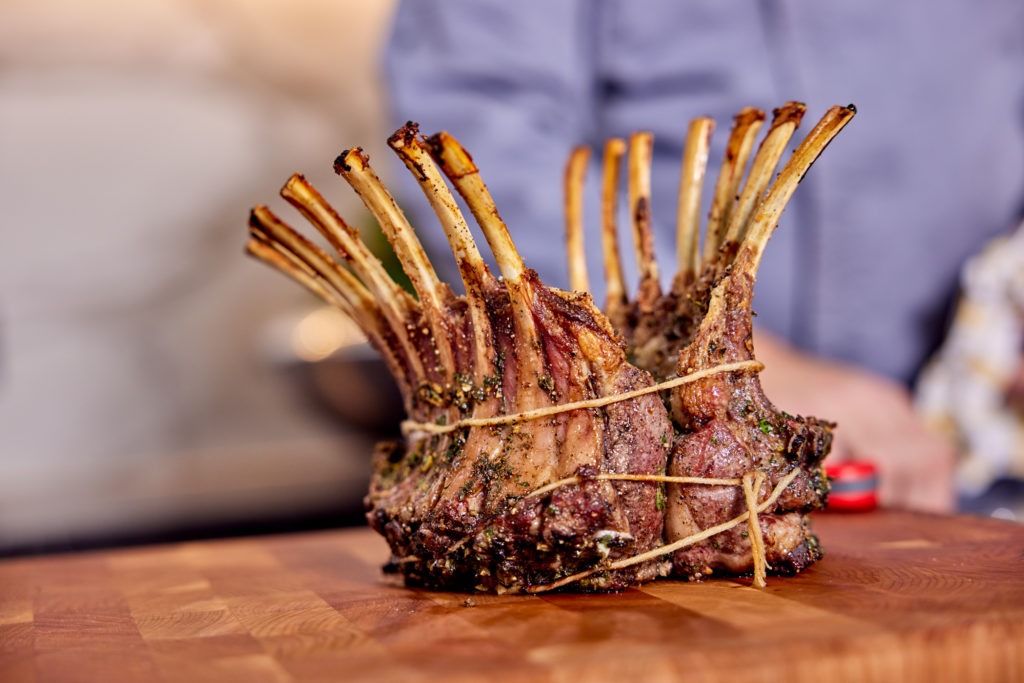
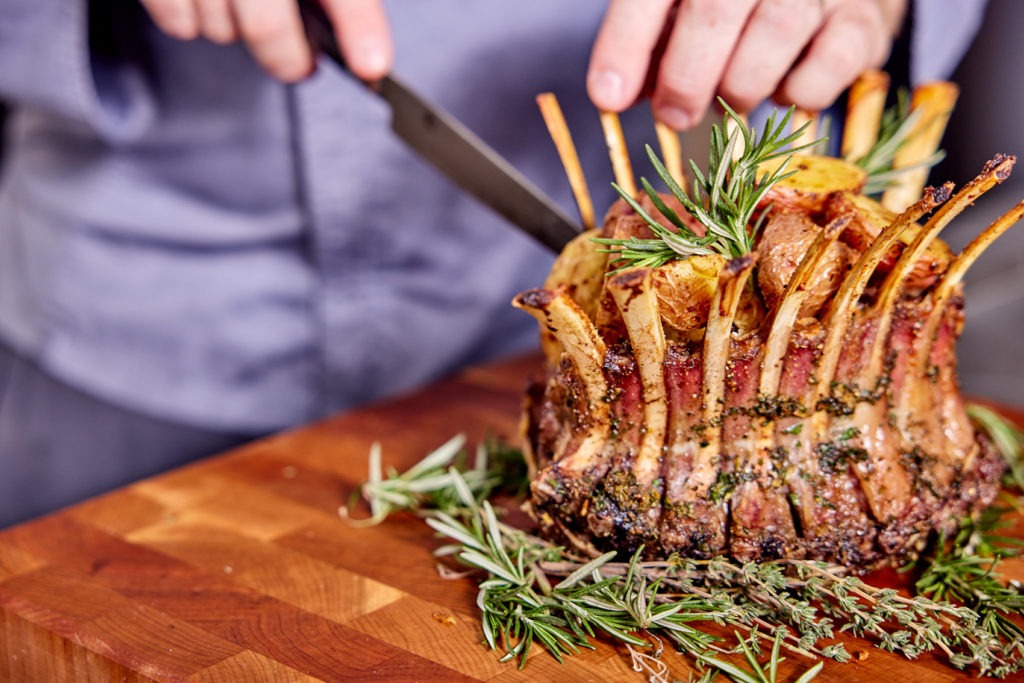


Very helpful. I’m going to try it. I have three racks. Will the same technique work for making the crown?
By the way, I’m so dependent on my trusty Thermopen, but his is the first time I’ve been tempted by your Chef Alarm. Grandma should have put it on her list!
Kelly,
Three racks is a trickier problem. You actually want to sew the racks together using butcher twine and a fat needle. Still cut the slits between ribs, but you can omit the one along the loin. Sew the racks end to end and then join the outermost two ends and sew them together. The cook time will be the same—possibly slightly longer.
The ChefAlarm really is a great tool for this kind of thing. Maybe someone will surprise you with it?
Thanks for this recipe, and technique! If I want to grill it, should it go directly on the grill, or would you recommend a pan still?
Also, if I can’t get fresh herbs, what is the formula to use dried herbs instead?
Marc,
Grilling this would be delicious. It could go right on the grill, but maybe do it in two stages: off the direct heat to get to about 100°F, then on direct heat to finish it.
In general, use about 2/3 as much dried as fresh herbs.
Would a pork crown roast use the same cooking technique. Would done temp be the same. What cook temp?
Hans,
A crown pork roast is very similar! The pull temp for pork is 145°F, so warmer than for lamb. Also with the thicker meat, it’s better to cook it at a lower temperature. I’d go with something in the range of 350–375°F rather than 425°F.
I put the rub on the chops abt. 4 hrs. before and refrigerated. Grilled on Weber. Small water pan underneath. Grill temp held abt. 350°f. Used hardwood charcoal with pecan chunks surrounding water pan for indirect heating. Pulled crown roast at 130° – 135°. Rested for 10 min. Cut & plated, then microwaved for 1 min to bring temp up to serve. One of my best dishes ever! I truly enjoyed all the praises from our guests. Thanks for the recipe.
I’m so glad it turned out well! Keep cooking!